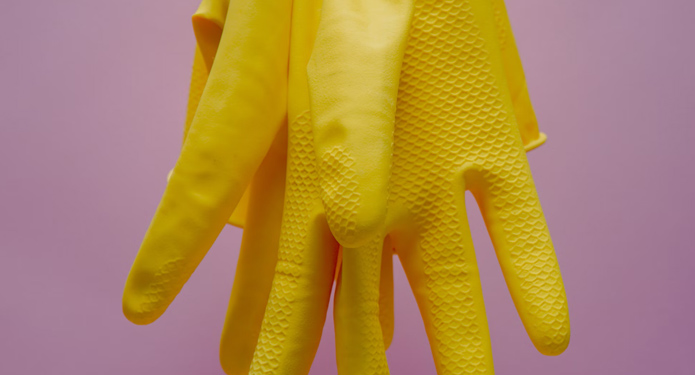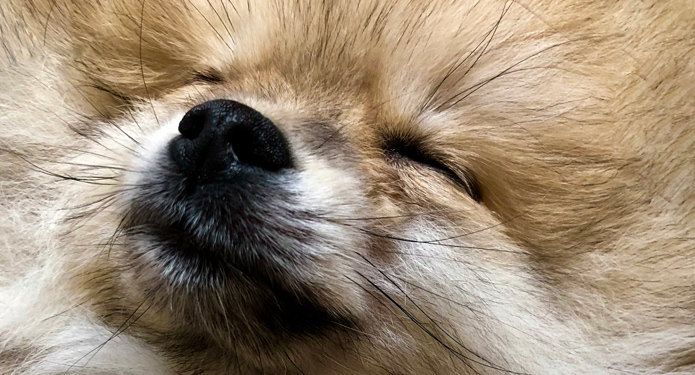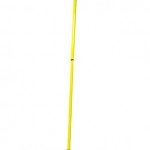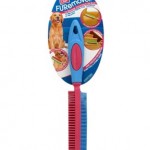
If you have pets, you have pet hair. It doesn’t matter if it comes from a cat or a dog, because shedding fur can create a real mess in any pet owner’s home. Large clumps can accumulate over time, and surfaces can get coated. You can always break out a vacuum cleaner to do a thorough cleaning and eliminate every strand, but it’s also nice to have quick and simple techniques to deal with small areas, or small amounts of fur. This cleaning tip came in from a loyal customer, and upon testing the tip, we found out that it does actually work. If you’re in a pinch, and short for time, continue reading to find out how you can use regular old rubber cleaning gloves to quickly clean pet hair on a wide range of surfaces.
Shedding pet fur can be a real pain, but when you get rid of it with a fast and easy method, it can be a little bit easier to live with. Before you call in a maid, or get rid of your pet, try this helpful cleaning tip to see if it works for you.
Cleaning Tip:
I found a very fast way to remove pet hair from furniture. I put on a pair of those long yellow kitchen gloves with the little nubbly bumps on the fingers and palms. Just swipe the surface and it removes pet hair like a charm. When I am done I just wash my hands with the gloves on and am ready for whatever new task that needs to be done.
How To Clean Pet Hair With Rubber Gloves:
Rubber gloves work well for picking up pet hair due to several factors:
- Friction: Rubber gloves have a textured surface that creates friction when rubbed against fabrics or surfaces. This friction helps to dislodge pet hair from the fibers and allows it to adhere to the surface of the glove.
- Static Electricity: When rubber gloves are rubbed against certain materials, such as upholstery or clothing, they generate static electricity. This static charge attracts pet hair, making it easier to lift off the surface.
- Grip: The rubber material of the gloves provides a firm grip on pet hair, allowing it to be easily picked up and removed from various surfaces.
- Flexibility: Rubber gloves are flexible and can conform to the contours of different surfaces, allowing you to reach into crevices and tight spaces where pet hair may accumulate.
- Reusable: Rubber gloves are reusable and can be washed and dried for repeated use. This makes them a cost-effective and environmentally friendly option for cleaning up pet hair.
Overall, the combination of friction, static electricity, grip, and flexibility makes rubber gloves an effective tool for picking up pet hair from upholstery, carpets, clothing, and other surfaces around the home. Their versatility and ease of use make them a popular choice for pet owners looking for efficient ways to keep their homes free from pet hair.
What Are The Best Places To Use Rubber Gloves For Pet Hair?
Rubber gloves can be used effectively for cleaning pet hair from various surfaces around the home. Some of the best places to use rubber gloves for cleaning pet hair include:
- Upholstered Furniture: Rubber gloves are excellent for removing pet hair from upholstered furniture such as sofas, armchairs, and ottomans. Simply run the gloved hand over the fabric to lift and collect pet hair.
- Car Interiors: Use rubber gloves to clean pet hair from car seats, carpets, and floor mats. The gloves’ textured surface helps to grip and remove hair from the upholstery and carpet fibers.
- Pet Bedding: Rubber gloves can be used to remove pet hair from pet bedding, blankets, and pillows. Rub the gloves over the surface to collect loose hair and keep your pet’s sleeping area clean and hair-free.
- Clothing and Fabrics: If pet hair has transferred onto your clothing, bedding, or curtains, rubber gloves can help remove it quickly and easily. Simply run the gloved hand over the fabric to pick up the hair.
- Rugs and Carpets: Use rubber gloves to remove pet hair from rugs and carpets by rubbing the gloves over the surface in a sweeping motion. The gloves’ textured surface helps to dislodge hair from the carpet fibers.
- Stairs and Hard-to-Reach Areas: Rubber gloves are ideal for cleaning pet hair from stairs, corners, and other hard-to-reach areas where vacuum cleaners may struggle to reach. Use the gloves to collect hair from these areas with ease.
- Pet Grooming: Rubber gloves can also be used for grooming your pet and removing loose hair from their coat. Simply run your gloved hand over your pet’s fur to collect loose hair and reduce shedding.
- Lint Brushes and Lint Rollers: You can also use rubber gloves as makeshift lint brushes or lint rollers by rubbing them over clothing or upholstery to pick up pet hair. The gloves’ textured surface helps to trap and remove hair effectively.
By using rubber gloves for cleaning pet hair in these areas, you can effectively remove loose hair and keep your home clean and hair-free. Remember to wash the gloves after use to remove any collected hair and debris, allowing them to be reused for future cleaning tasks.
Why Clean Pet Hair Anyway?
Cleaning shedding fur is important for several reasons:
- Maintaining Cleanliness: Shedding fur can accumulate on surfaces throughout the home, including furniture, floors, clothing, and bedding. Regular cleaning helps to prevent the buildup of fur and maintain a clean and hygienic living environment.
- Reducing Allergens: Pet dander, which includes shed fur, saliva, and skin particles, can trigger allergies and respiratory problems in some individuals. Removing shed fur helps to reduce the presence of allergens in the home and improve indoor air quality, particularly for allergy sufferers.
- Preventing Odors: Accumulated pet fur can trap odors, such as pet dander, urine, or saliva, leading to unpleasant smells in the home. Regular cleaning helps to remove fur and associated odors, keeping your home smelling fresh and clean.
- Preventing Matting and Tangles: Pets with long or dense fur are prone to matting and tangles if their fur is not regularly groomed and cleaned. Removing shed fur helps to prevent mats and tangles from forming, reducing discomfort and potential skin issues for your pet.
- Preventing Damage to Surfaces: Over time, accumulated pet fur can cause damage to surfaces such as upholstery, carpets, and clothing. Fur fibers can become embedded in fabrics and carpet fibers, leading to wear and tear and reducing the lifespan of these items.
- Improving Appearance: A clean and fur-free home is more visually appealing and inviting. Regular cleaning helps to maintain the appearance of your home and ensures that guests feel comfortable and welcome when visiting.
- Reducing Pest Infestations: Shed fur can attract pests such as dust mites, fleas, and ticks, which thrive in environments with high levels of organic matter. Removing shed fur helps to reduce the risk of pest infestations and keeps your home pest-free.
Overall, cleaning shedding fur is essential for maintaining a clean, healthy, and comfortable living environment for both you and your pets. By implementing regular cleaning routines and using effective cleaning tools and methods, you can minimize the impact of shedding fur and enjoy a cleaner and more enjoyable home environment.

How Often Should You Clean Pet Hair?
The frequency of cleaning pet hair depends on various factors, including the shedding rate of your pet, the type of pet hair, and your personal preferences. While there’s no one-size-fits-all answer, here are some general guidelines to help you determine how often to clean pet hair:
Daily Maintenance
Consider incorporating daily maintenance tasks to manage pet hair, especially if you have pets that shed heavily or have long fur. Daily activities may include using a lint roller or pet hair remover on clothing and upholstery, vacuuming high-traffic areas, and grooming your pet to remove loose hair.
Weekly Cleaning
Schedule weekly cleaning sessions to remove pet hair from floors, carpets, and furniture throughout your home. Use a vacuum cleaner with a pet hair attachment or a specialized pet hair vacuum to effectively remove hair from carpets, rugs, and upholstery. Additionally, dust and mop hard surfaces to pick up any loose pet hair that may have accumulated.
Bi-Weekly or Monthly Deep Cleaning
Consider deep cleaning your home every two weeks to a month, focusing on areas that may accumulate pet hair over time, such as baseboards, vents, and behind furniture. Use a damp microfiber cloth or electrostatic duster to remove hair from surfaces and crevices, and vacuum or sweep under furniture to reach hidden pet hair.
Seasonal Cleaning
Perform seasonal cleaning tasks to address specific challenges associated with shedding, such as seasonal changes in your pet’s coat or increased shedding during certain times of the year. Consider using shedding tools or grooming brushes designed for your pet’s coat type to help manage shedding and reduce the amount of loose hair in your home.
As Needed Cleaning
Be proactive in cleaning pet hair as needed, especially after activities that may exacerbate shedding, such as grooming sessions, outdoor playtime, or bathing your pet. Quickly addressing pet hair buildup can help prevent it from spreading throughout your home and becoming more difficult to manage.
Regular Grooming
Incorporate regular grooming sessions into your pet care routine to help reduce shedding and minimize the amount of loose hair in your home. Brushing your pet’s coat regularly helps to remove loose fur and distribute natural oils, keeping their coat healthy and reducing shedding.
By establishing a regular cleaning routine and addressing pet hair accumulation proactively, you can effectively manage pet hair in your home and maintain a clean and comfortable living environment for both you and your pets. Adjust your cleaning frequency based on your pet’s shedding patterns, lifestyle factors, and the specific cleaning needs of your home.
What Type Of Gloves Are Best?
When it comes to cleaning pet hair, certain types of gloves may work better than others. Here are some considerations to keep in mind when choosing gloves for cleaning pet hair:
- Rubber Gloves: Rubber gloves with textured or nitrile-coated surfaces are effective for picking up pet hair due to their friction and grip. These gloves create static electricity when rubbed against surfaces, helping to attract and lift pet hair from upholstery, carpets, and clothing.
- Latex Gloves: Latex gloves provide a similar gripping effect to rubber gloves and can be effective for removing pet hair from surfaces. However, latex gloves may cause allergic reactions in some individuals, so it’s essential to consider any allergies or sensitivities before using them for cleaning.
- Nitrile Gloves: Nitrile gloves offer durability and flexibility, making them suitable for cleaning tasks involving pet hair. Like rubber gloves, nitrile gloves provide a textured surface that helps to grip and lift pet hair from various surfaces.
- Grooming Gloves: Grooming gloves are specifically designed for pet grooming and can be used to remove loose hair from your pet’s coat. These gloves typically feature soft rubber or silicone bristles that massage your pet’s skin while effectively removing loose fur. Grooming gloves can also be used to pick up pet hair from furniture and upholstery.
- Microfiber Gloves: Microfiber gloves are soft and gentle on surfaces, making them suitable for cleaning delicate items such as electronics or glass surfaces. While microfiber gloves may not provide as much grip as rubber or nitrile gloves, they can still be effective for picking up pet hair when used with a dampened surface.
When choosing gloves for cleaning pet hair, consider factors such as the type of surfaces you’ll be cleaning, the level of shedding from your pet, and any personal preferences or sensitivities. Experiment with different types of gloves to find the option that works best for your cleaning needs and helps you effectively manage pet hair in your home.
Are There Other Rubber Tools For Cleaning Pet Hair?
Yes, there are several rubber tools designed specifically for removing pet hair from various surfaces. These tools utilize rubber’s natural properties, such as friction and static electricity, to effectively lift and collect pet hair. Here are some popular rubber tools for cleaning pet hair:
- Rubber Broom: Rubber brooms feature rubber bristles that attract and trap pet hair from floors, carpets, and rugs. They are particularly effective for removing pet hair from hard surfaces such as tile, hardwood, and laminate flooring. Rubber brooms can be used dry or slightly dampened for enhanced cleaning.
- Rubber Pet Hair Remover Brush: Rubber pet hair remover brushes have a rubberized surface that grips and lifts pet hair from upholstery, furniture, and clothing. These brushes are handheld and typically feature a contoured shape for comfortable use. They are suitable for use on a variety of fabrics and surfaces.
- Rubber Squeegee: Rubber squeegees are versatile tools that can be used to remove pet hair from a variety of surfaces, including carpets, rugs, and upholstery. The rubber blade effectively lifts and collects pet hair while the squeegee’s handle provides control and maneuverability. Squeegees are particularly useful for removing pet hair from car interiors and windows.
- Rubber Carpet Rake: Rubber carpet rakes feature rubber bristles that penetrate deep into carpet fibers to loosen and lift embedded pet hair. These rakes are designed to be used before vacuuming to agitate the carpet and release trapped pet hair. They can also be used on upholstery and area rugs.
- Rubber Gloves: As mentioned earlier, rubber gloves can be used to clean pet hair from various surfaces by creating friction and static electricity. Simply don a pair of rubber gloves and rub them over the surface to collect pet hair. The gloves’ textured surface helps to grip and lift hair from upholstery, carpets, and clothing.
These rubber tools are designed to make pet hair removal easier and more efficient, saving you time and effort in cleaning up after your furry friends. Experiment with different tools to find the ones that work best for your specific cleaning needs and surfaces.





 Ordering Info
Ordering Info Customer Service
Customer Service Follow Us
Follow Us Search For Stuff
Search For Stuff Find Us
Find Us Call Us
Call Us Pay Us
Pay Us

0 Comments so far.
Use the form below to add your own thoughts or questions. Scroll down to read what other people had to say.